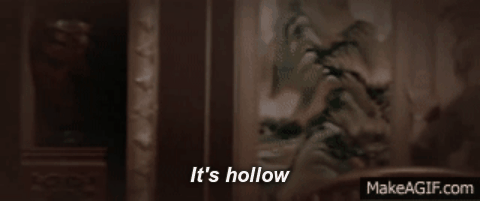Dungeons in Fate: Secrets
Nov. 22, 2016, 11:38 a.m.
Welcome back again for another post in my Dungeons in Fate series. If you haven't read the previous articles, I am going through various tips for adding dungeons into your Fate games while still maintaining the narrative philosophies of Fate. In this post I'll be expanding on a topic I touched on in my previous article about traps. Today, I'll talk about using secrets in your dungeon.
"The heroes make their make their way down a dimly-lit narrow corridor with nothing but a single lantern to guide their way. As they creep around the bend, they see ahead of them a crafty Gnome wizard, Berkle, the very person they have been tasked to capture. The wizard spots the group and quickly dashes down a corridor. The party follows suit and charges after the small creature. They begin to gain on the wizard. 'We've got him cornered,' yells one of the adventurers as Berkle turns into a room, out of the heroes' sight. The group rushes through the doorway and . . . the room is empty with no exits other than the door they entered through. Where could the wizard be? Did he turn invisible? Is there a secret door?"
 \
Dungeons often are meant to be mysterious and convey a sense of wonder, making
secrets a powerful tool when creating dungeons in an RPG. However, secrets
in-game are very different from secrets in real life. When we think of secrets,
we usually think of information that must be kept secret and cannot be shared,
but in an RPG if the players never discover a secret it is as if it never
existed. All the players have is what is in the narrative, so if a secret is not
found, in their eyes, it doesn't exist.
\
Dungeons often are meant to be mysterious and convey a sense of wonder, making
secrets a powerful tool when creating dungeons in an RPG. However, secrets
in-game are very different from secrets in real life. When we think of secrets,
we usually think of information that must be kept secret and cannot be shared,
but in an RPG if the players never discover a secret it is as if it never
existed. All the players have is what is in the narrative, so if a secret is not
found, in their eyes, it doesn't exist.
So I'm going to go against the advice of the phrase "Loose lips sink ships," and tell you to reveal your secrets. I don't mean that you should tell your players everything, but you should hint at it. In the short narrative above, there is a secret. Berkle, the wizard, ran into a dead end, but he was no where to be found. By setting up a scene in this way, the players know there is a secret to be found. They know that there is some hidden way of either hiding in or escaping the room. This sets them up to use their skills to find whatever secret there may be.
 There are two ways to handle the player interaction at this point. One option is
to plan out what happened. In the example, I was thinking that there is a hidden
door in this room. If the players try searching for clues, they might find
footprints leading straight into the wall, subtle straight seems in one section
of the wall, or even a small hidden switch that opens the door. The other option
is to not plan the outcome. Let the players guess at what the secret is and make
rolls to determine if they are right. This makes for a more fluid dungeon that
is actually being built by the players, but it does require more thinking on
your feet.
There are two ways to handle the player interaction at this point. One option is
to plan out what happened. In the example, I was thinking that there is a hidden
door in this room. If the players try searching for clues, they might find
footprints leading straight into the wall, subtle straight seems in one section
of the wall, or even a small hidden switch that opens the door. The other option
is to not plan the outcome. Let the players guess at what the secret is and make
rolls to determine if they are right. This makes for a more fluid dungeon that
is actually being built by the players, but it does require more thinking on
your feet.
To take this one step further, you don't even have to pre-plan where your secrets are necessarily. You can put an aspect on the dungeon itself to clue your players in. Make the aspect something like Mysterious Dungeon or Hidden Secrets, and wait for opportunities to arise to compel the aspect and throw complications at the party. When you do this, remember to setup the secrets in a way that gives the players a hint. The players can also take advantage of the aspect and search for secrets. If they succeed, reward them by giving them something to find. It might be a good idea to at least throw together a list of possible secrets to find with this method, even if they don't have a designated location.
So there are some ideas of how to add some mystery to your dungeons without your players walking right passed it. What tricks have you used to add secrets to your Fate games?
Tags: dungeons fate core tips ttrpg
Older Post Newer Post
Copyright © 2018, Nathan Hare
All rights reserved
